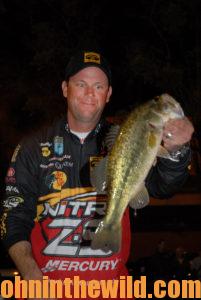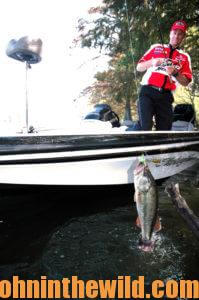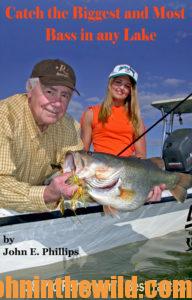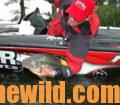Editor’s Note: Seven Bassmaster Angler-of-the-Year titles, four of those consecutively, and four Bassmaster Classic Championships make Kevin VanDam of Kalamazoo, Michigan, one of the most-consistent bass anglers on the professional-bass-fishing circuit today. Here’s what VanDam says about his secrets to consistency.
When I’m fishing a ledge, I try to let the bass tell me where they’re holding on that ledge on that day. Where the bass are holding on a break on any given day depends on the amount of current coming to the lake from hydroelectric-power generation. In a fast current, the bass typically will pull-up on top of the  ledge and to the most-shallow part of the ledge. On a slow current, the bass may be holding right on the break of the drop-off. With no current, the bass may be suspended off the edge of the break. I experiment with various crankbaits, running them at different depths to try to get a bite. Once I get a bite, I’ll know how the bass are positioned on that bottom break. Once I know where the bass are holding, I can position my boat to fish that water depth and select the crankbait designed to run at that water depth.
ledge and to the most-shallow part of the ledge. On a slow current, the bass may be holding right on the break of the drop-off. With no current, the bass may be suspended off the edge of the break. I experiment with various crankbaits, running them at different depths to try to get a bite. Once I get a bite, I’ll know how the bass are positioned on that bottom break. Once I know where the bass are holding, I can position my boat to fish that water depth and select the crankbait designed to run at that water depth.
I’ve learned that bass will change their holding positions often during the day. To consistently find and catch big bass on lakes with hydroelectric-power generation, I’ll call the power company on those lakes to learn the power-generation schedule and know when they’ll start pulling water and running current. Then, when the time comes close to when the current’s supposed to be running, I watch the sticks and the limbs that are sticking-out of the water to see if I can see the current moving. This tells me how I need to position my boat to fish for the bass on the ledges.
Most bass fishermen will cast onto a shallow flat, bring their crankbaits over the lips of the breaks and then back to their boats. Or, they try to parallel that bottom break, so their lures are running right on the edges of the breaks. I’ll sometimes put my boat on the shallow side of the drop-off, cast-out to the deep side and bring my crankbait from the deep water over the lip of the break and up to the shallow side of the break. I use this tactic when I’m fishing a bottom break I know is holding bass. I’ve learned that when I can show the bass my crankbaits coming from a different angle than they’re accustomed to seeing, I can trigge r a strike that I never will have gotten if I’ve continued to fish from the same direction from which I’ve fished earlier. Also, when I know the bass are inactive, I may change from a crankbait, cast a Football Jig out into the deep water and drag it from the deep water, up the ledge, over the top of the ledge and into the shallow water. Many times that action will elicit strikes that I may not have gotten with a crankbait. When you pinpoint a ledge where you know the bass are holding, oftentimes you’ll have to vary the position of your boat, not just your lures and the types of retrieve you’re using. To catch bass on a ledge, you may have to bring your bait from several-different directions to find out which way the bass want to take the bait. That’s one of my keys to consistency.
r a strike that I never will have gotten if I’ve continued to fish from the same direction from which I’ve fished earlier. Also, when I know the bass are inactive, I may change from a crankbait, cast a Football Jig out into the deep water and drag it from the deep water, up the ledge, over the top of the ledge and into the shallow water. Many times that action will elicit strikes that I may not have gotten with a crankbait. When you pinpoint a ledge where you know the bass are holding, oftentimes you’ll have to vary the position of your boat, not just your lures and the types of retrieve you’re using. To catch bass on a ledge, you may have to bring your bait from several-different directions to find out which way the bass want to take the bait. That’s one of my keys to consistency.
I’m also consistently successful because I’ve helped design some of these lures. Strike King
(https://www.strikeking.com/) and I want to develop shapes and colors that make our soft-plastic lures better than any others on the market. But first we wanted our soft-plastic lures to have an edge. We wanted our soft-plastic lures to be constructed with better material than the materials other companies used to make their soft-plastic lures. So, we came-up with a new type of plastic – the Perfect Plastic – for our finesse worms. We wanted a softer plastic with a heavy salt content to give the bait a good sink rate, especially when the worm was rigged wacky style. The salt also made the worm heavier than most finesse worms, allowing you to cast it without having to add weight to the worm or the hook. The tails on most straight-tailed worms (finesse worms) had no action. We w anted the Perfect Plastic Finesse Worm’s tail to have action. The tail’s flipping and moving makes this finesse worm very versatile, whether you’re fishing it on a Carolina rig, a shaky-head jig or a Texas rig.
anted the Perfect Plastic Finesse Worm’s tail to have action. The tail’s flipping and moving makes this finesse worm very versatile, whether you’re fishing it on a Carolina rig, a shaky-head jig or a Texas rig.
I like to fish the 7-inch 3X Elaztech Finesse Worm. Of course, that decision on what to fish depends on the lake I’m fishing. In tournaments, I fish for big bass. The 7-inch Finesse Worm gives me the properties and the actions of a finesse worm in a longer profile. When you say the words finesse worm, you usually think about a 4-1/2- or a 5-inch worm. However, if you can get the action and the finesse technique in a larger-size finesse worm, then you can attract larger bass. If I’m fishing a smallmouth lake, I’ll choose a 5-inch KVD Perfect Plastic Finesse Worm. If I’m fishing a lake with a number of spotted bass, I’ll use the smaller Finesse Worm. I’m not a one-lure fisherman. If I’ll be fishing a Finesse Worm, I want it in my boat in several sizes to let the bass tell me which size they want to eat on the day I’m fishing. If they won’t eat the 7-inch Finesse Worm, I’ll present them with the 5-inch worm. However, when I’m targeting bigger bass, the 7-inch Finesse Worm is my lure of choice.
I choose my lure colors based on water clarity, the amount of sunlight the water gets and the depth at which I’m fishing. But if I only can pick three Finesse Worm colors this is what I’d choose. If I only could pick one color to fish anywhere in the nation, more than likely I’ll choose green pumpkin. But dirt-colored Finesse Worms are my favorite almost anywhere that I fish, if the water’s clear or slightly stained. If the water’s dirty, or I’m fishing in Florida, I prefer the Junebug or the redbug color.
To learn more about Kevin VanDam and his fishing, go to www.kevinvandam.com.
 To learn more about bass fishing, check out John E. Phillip’s book, “Catch the Biggest and the Most Bass in Any Lake,” at http://amzn.to/Xd7qez, available in Kindle and print versions and
To learn more about bass fishing, check out John E. Phillip’s book, “Catch the Biggest and the Most Bass in Any Lake,” at http://amzn.to/Xd7qez, available in Kindle and print versions and
Click here for the Audible link.
Tomorrow: Don’t Abandon the Spinner Bait for Catching Bass with Kevin VanDam










